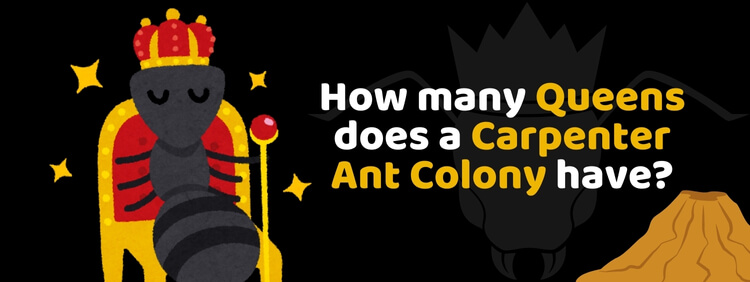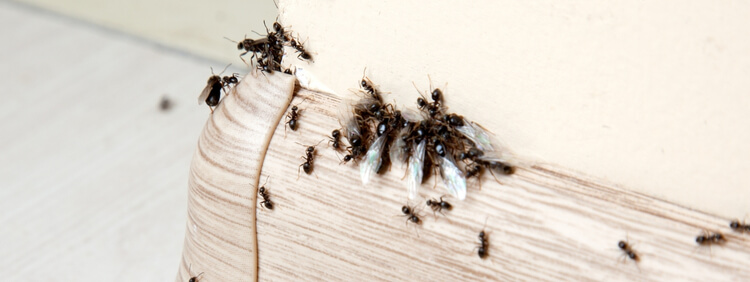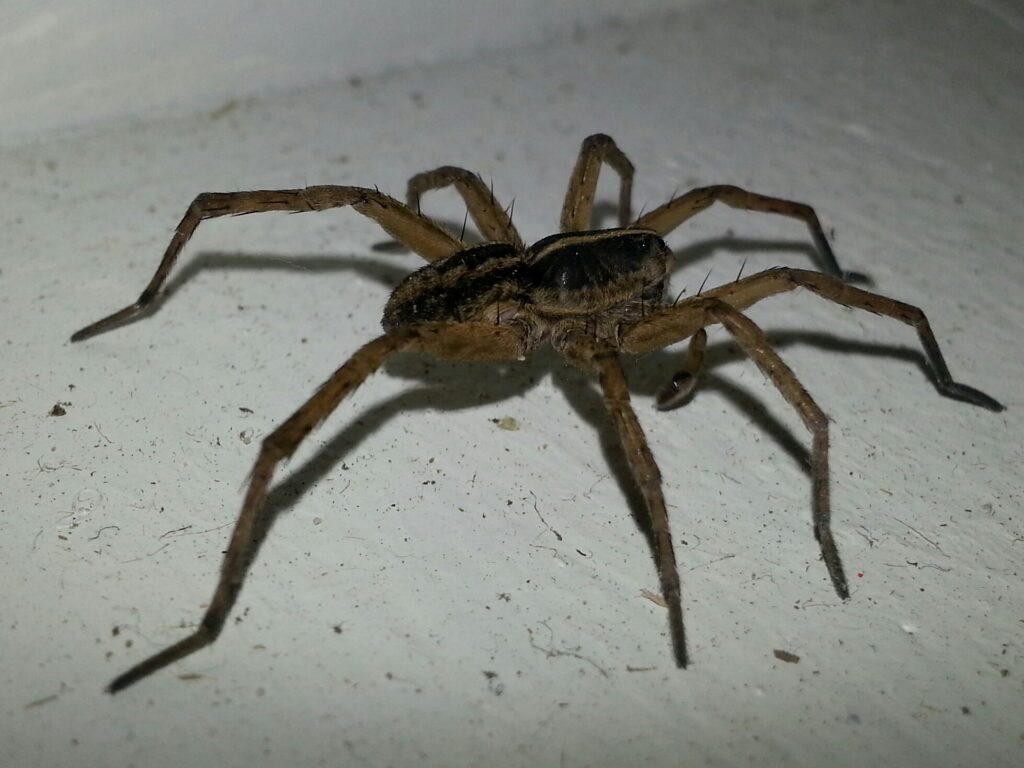 Picture yourself relaxing at home on a sunny afternoon. Suddenly, you notice a trail of tiny invaders disrupting the tranquillity of your living space. Bringing about unheard-of havoc, these seemingly insignificant insects are none other than carpenter ants, and their reign could spell trouble for your tranquil abode.
Understanding the inner workings of a carpenter ant dwelling, marked by its unique matriarchal setup, can be enthralling. The lifespan of a regal queen ant extends much beyond that of her loyal subjects, offering an interesting dimension to study. And if there is an infestation to tackle, getting insight on how to attract the queen out of her den could prove useful.
However, it's crucial to tread carefully while attempting carpenter ant control. A haphazard approach could cause more harm than good, calling for the expertise of a seasoned pest control expert.
Throughout this insightful journey, we aim to delve deeper into the intriguing world of carpenter ants, their nesting habits, and the best preventive methods. Plus, find out exactly why our team is the top choice for carpenter ant control.
Picture yourself relaxing at home on a sunny afternoon. Suddenly, you notice a trail of tiny invaders disrupting the tranquillity of your living space. Bringing about unheard-of havoc, these seemingly insignificant insects are none other than carpenter ants, and their reign could spell trouble for your tranquil abode.
Understanding the inner workings of a carpenter ant dwelling, marked by its unique matriarchal setup, can be enthralling. The lifespan of a regal queen ant extends much beyond that of her loyal subjects, offering an interesting dimension to study. And if there is an infestation to tackle, getting insight on how to attract the queen out of her den could prove useful.
However, it's crucial to tread carefully while attempting carpenter ant control. A haphazard approach could cause more harm than good, calling for the expertise of a seasoned pest control expert.
Throughout this insightful journey, we aim to delve deeper into the intriguing world of carpenter ants, their nesting habits, and the best preventive methods. Plus, find out exactly why our team is the top choice for carpenter ant control.
How Many Queens Does a Carpenter Ant Colony Contain?
Increased understanding of carpenter ants can provide homeowners with unique insights that aid in managing an infestation. The social structure of these critters, in particular, is intriguing. Here is a brief breakdown:- Generally, a colony possesses a single matriarch, usually the most important of the group.
- However, certain colonies can have multiple matriarchs. These are known as oligogynous colonies.
- This multiple-queen phenomenon ensures survival through numbers and promotes rapid colony growth.
What are Other Unique Characteristics of Carpenter Ants?
Carpenter ants, the lumberjacks of the insect world, possess characteristics that are truly fascinating. These traits not only make them unique but also significant in the natural ecosystem. However, they could pose certain challenges for homeowners, making it imperative to understand their behaviour and life cycle thoroughly.- Life Span: How long does a queen ant live? Did you know that the head of the ant family, the sovereign insect, can often outlive many humans? Amazingly, these rulers live up to 15 years, which is quite an extended period in the insect world!
- Nocturnal Activity: While you may be stargazing or asleep, these woodworking insects are incredibly active. Night is their preferred time to venture out in search of food and expand their habitat.
- Fringed Hairs: Unlike their ant counterparts, they have circular ridged hairs on their abdomen, which aids them in their woodworking tasks.
- Formidable Size: Standing nearly half an inch, these insects cast a rather impressive figure within the ant kingdom.
What are the Telltale Signs of a Carpenter Ant Infestation in Your Home?
Unsettling as it may be to imagine a nest of insects lurking in your home, recognizing the indicators of a carpenter ant infestation is the first step toward restoration. Here are some distress signals to be on the lookout for:- Wood Shavings - These critters burrow through wood not for nutrition content but to establish their nests. Look for small, pile-like formations of fine wood debris in your home.
- Nocturnal Activity - Carpenter ants generally forage after hours, when they're less likely to be detected. If you notice night-time scrambling, it may be time to investigate.
- Rustling Sounds - When in large numbers, the quiet rustling movement of these ants inside their nests can be audible. Listen for faint, crackling sounds, especially at night.
- Swarmers - These are the winged variety of the carpenter ants, and their purpose is to start new colonies. Sightings of these in your home are a clear warning sign of a nearby colony.
- Ant Trails - Carpenter ants follow scent trails left by their peers. Noticing long lines of ants dragging food to an unseen location? It might be a colony.
Why is DIY Carpenter Ant Eradication Potentially Dangerous?
 While many homeowners might be tempted to tackle ant-related issues independently, it's important to understand the risks involved. Inexperience and a lack of understanding about carpenter ants' complex life cycles can make DIY eradication methods both harmful and ineffective. Here's why:
While many homeowners might be tempted to tackle ant-related issues independently, it's important to understand the risks involved. Inexperience and a lack of understanding about carpenter ants' complex life cycles can make DIY eradication methods both harmful and ineffective. Here's why:
- Potential to Spread the Problem: Inadequate or incorrect treatment methods can lead to the further spreading of the colony throughout your home.
- Health Risks: The improper use of chemicals, often a significant part of DIY pest management, can pose risks to your health and that of your family.
- Damage to Property: As time is crucial when it comes to pest problems, unsuccessful eradication attempts may allow more ants to survive, hence causing more damage.
- Incomplete Eradication: It's easy to miss hidden ant trails, nests, and queens, causing the issue to recur.
What are the Proven Methods to Coax a Queen Ant Out of Her Nest?
As a homeowner, your best bet in managing an intrusion of these wood-loving insects is accessing the heart of the issue - the queen. Here are the universally acknowledged practices on how to lure a queen ant out of its nest:- Food Trails: Food, particularly sweet or protein-rich items, can be a powerful attractant. Leaving a trail of suitable food items from the nest to a trap can be a successful strategy.
- Pheromone Traps: Pheromones are chemicals ants use for communication. They are especially potent for attracting ant colonies, including the queen. Commercial pheromone traps are available for this purpose.
- Insecticides: Certain pesticides designed specifically for ant nest management have a dual action: they not only exterminate the insects but also act as an attractant. It's important to consult an expert before using any chemicals.
- Professional Pest Control Services: When amateur efforts fail, or if the problem is severe, a professional pest control expert is the recommended solution. They have specialized tools and the knowledge to handle a severe infestation.
What are the Benefits of Hiring a Pest Control Expert for Carpenter Ant Control and Prevention?
When faced with the reality of a troublesome swarm, homeowners might feel inclined to handle the situation themselves. However, the value of obtaining expert aid in these situations cannot be understated. Here, we highlight the advantages of engaging professional services to manage and prevent insect-related issues.- Effective Protection: Pest management experts provide comprehensive protection against different insect threats, as they harness an in-depth understanding of insect behaviours and life cycles. This expertise extends to uncovering infestations that may have been undiscovered.
- Safety Assurance: Professional service providers adhere to stringent safety protocols to ensure that their pest management techniques are non-hazardous for homeowners and their surroundings.
- Long-term Solutions: Pest professionals not only remove immediate threats but also implement deterrent measures against potential future invasions. Their strategies range from sealing entry points to advising you on preventative home maintenance.
- Time and Cost-Efficient: Engaging expert services ensures that the insect issue gets resolved promptly, eliminating any potential for the problem to escalate. This expedience saves homeowners the additional costs associated with extensive damage repair.
- Educative Support: A crucial aspect of a pest expert's role is to educate homeowners on how to promptly identify potential signs of insect activity. This guidance empowers homeowners to detect any early signs of trouble, preventing possible re-infestations.

